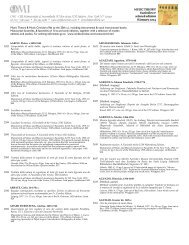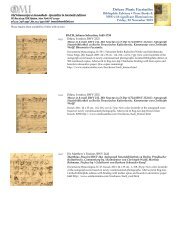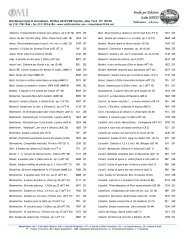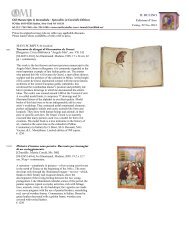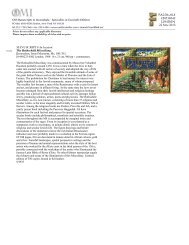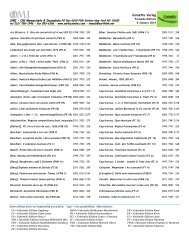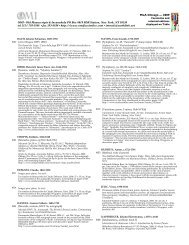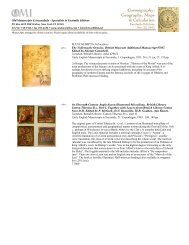CIMA 63 Titel Inhalt
CIMA 63 Titel Inhalt
CIMA 63 Titel Inhalt
Erfolgreiche ePaper selbst erstellen
Machen Sie aus Ihren PDF Publikationen ein blätterbares Flipbook mit unserer einzigartigen Google optimierten e-Paper Software.
20<br />
5. Tract on the 36 constellations<br />
(fols 312r-319r and 323r-326r)<br />
This section contains illustrations of the constellations in the following order: Draco<br />
inter Arctos, Draco, Hercules, Corona, Serpentarius, Bootes, Auriga, Cepheus,<br />
Cassiopeia, Pegasus, Andromeda, Perseus, Triangulum, Pleiades, Lyra, Cygnus, Vultur<br />
Volans, Vultur Cadens, [Cetus, Eridanus, Figura Sonans Canonem, Delphinus, Orion,<br />
Canis, Lepus, Argo, Austronotus,] Daemon Meridianus, Piscis Magnus, Ara,<br />
Centaurus, Vexillum, Hydra, Antecanis, Equus Minor, and Terebellum (the nine<br />
constellations in square brackets take place on fols 323v-326r). The illustrations are<br />
accompanied by a short explanatory text and by the corresponding geomantic figure(s).<br />
Descriptions of the 48 constellations can be traced back to Antiquity, in the first place<br />
to the Phaenomena of Aratos of Soloi (third century B.C.), which gave birth to rich<br />
Greek, Latin and Arabic traditions. The sequence, as well as the forms and the names<br />
of the constellations in the ‗Tübingen Book‘ ultimately derive from the Liber<br />
introductorius of Michael Scot (died ca. 1235), the famous astrologer of Frederick II<br />
Hohenstaufen, who mixed the Latin and Arabic traditions in an entirely original way. 14<br />
The main change is the omission of the 12 zodiacal signs, which is of course to be<br />
explained by the fact that they have been dealt with sufficiently earlier in the ‗Tübingen<br />
Book‘.<br />
14 The constellation cycles in medieval and Renaissance manuscripts (including the ‗Tübingen<br />
Book‘), have been studied by Rembrandt DUITS, ‗Celestial Transmissions. An Iconographical<br />
Classification of Constellation Cycles in Manuscripts (8 th -15 th Centuries)‘ (forthcoming in<br />
Scriptorium). ), see esp. ‗Series D3‘ and manuscript 139. Michael Scot‘s constellations are also<br />
described in Ulrike BAUER, Der ‘Liber introductorius’ des Michael Scotus in der Abschrift Clm<br />
10268 der Bayerischen Staatsbibliothek: ein illustrierter astronomisch-astrologischer Codex aus<br />
Padua, 14. Jahrhundert, München, 1983.



